As we age, our muscles start to decline. As you get into your late 60s, engaging in physical activities becomes strenuous unless you have maintained a regular training schedule through the years.
Older people may find starting exercises late in life to be challenging and near impossible. Even those with good physical health may struggle to meet the regular 30 minutes of physical activity recommended for a healthy lifestyle.
The discipline required to hit the gym at least three times a week and the learning curve in most of these exercises mean most seniors have to find other activities suited to their needs and limitations. Fortunately, such an option is not far out of reach.
You have two scientifically proven options you can use to achieve the benefits of physical activities. Walking and climbing stairs are your two options for reaping the benefits of physical exercise. The best part is that you can use them both together, integrating them into your day-to-day schedule. Also, you do not have to worry about rest days.
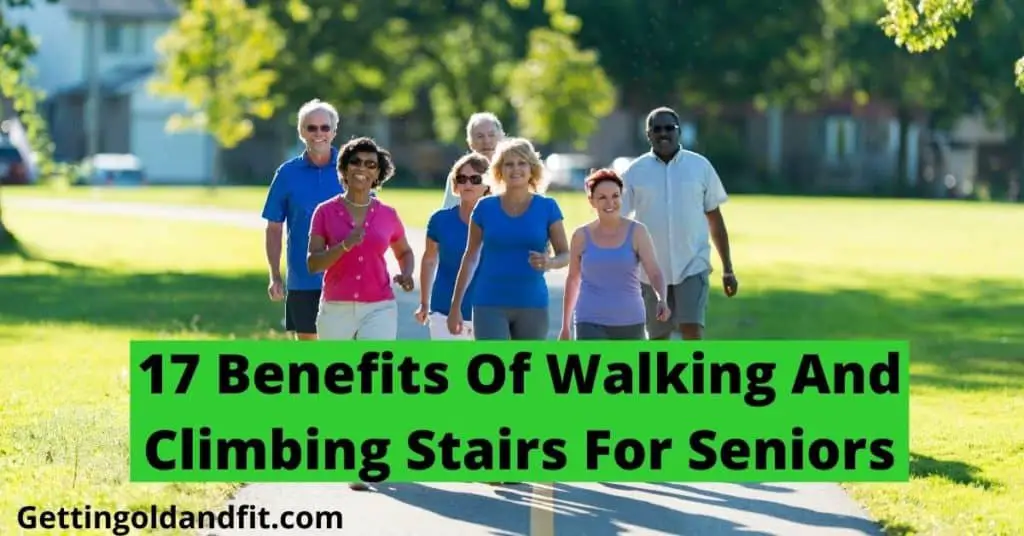
However, the most significant advantage they offer is the numerous health and social benefits you stand to gain by taking regular walks and climbing stairs. Here are the main benefits of walking and climbing stairs for seniors.
1. Improves Bones And Muscle Health
Conditions like osteoporosis affect older adults the most. Bone and muscle loss are some of the biggest problems for older adults. The loss of muscle reduces your strength and further makes you susceptible to bone loss.
I’ve written an article on do you lose muscle mass after 40?
Weakened bones increase the risk of bone fractures, which is why seniors are more susceptible to hip fractures.
Bone mass density peaks between 25 -30 years of age, and from there, your bone density starts decreasing, and they get weaker as you age. To help prevent osteoporosis, you have to engage in regular physical activity, which is challenging for most older adults.
One study found that by walking 30 minutes daily, seniors could reduce the risk of hip fracture by 40%. Climbing stairs, which is more intensive than walking, has even more significant benefits.
Walking and climbing stairs place your body weight against gravity creating the resistance needed to promote bone and muscle growth.
If you’re looking for other exercises to help with osteoporosis, I’ve written an article Is Resistance Training Good for Osteoporosis?
2. Improves Mental And Emotional Health
Another risk that comes with old age is deteriorating mental health. People in their late 60s to 80s have a high risk of memory loss, dementia, Alzheimer’s, and other brain-related complications.
Studies have shown a correlation between exercise and improved brain health; this happens in three ways.
- first, physical activity, which you can achieve by walking and climbing stairs, increases the amount of blood pumped into the brain; in doing this, your brain gets the necessary oxygen and nutrients, which helps you think clearly
- secondly, physical activity helps expand the size of your hippocampus, which is the part of the brain responsible for memory
- finally, it helps improve the nerve connections in your brain, boosting your memory and preventing injury and brain disease
That is not all, since thirty minutes of walking or climbing stairs can help you overcome other emotional issues like bad moods, anxiety and depression, ADHD, and PTSD.
Exercise releases endorphins and serotonin enzymes, and other chemicals that improve our moods and energize our spirit. For example, a recent study by the Harvard School of Public Health showed that walking could help you reduce the risk of major depression by 26 %.
In addition, exercising this way helps relieve body tension and stops the impact of negative distractions.
Walking has also been shown to work as effectively as anti-depressant drugs for mild to moderate forms of depression without the adverse effects and with more additional benefits.
The University of Virginia Health System established in a study that men between the ages of 71 and 93 who walked for a quarter a mile or more daily had halved the chances of suffering from Alzheimer’s disease and dementia than those who did not.
In general, the increased physical activity that comes with daily walks and climbing stairs reduces inflammation and promotes healthy brain activity, including neural growth and activity patterns.
These, in turn, promote calmness, improve your wellbeing and mental sharpness, and reduce the risk of degenerative brain diseases.
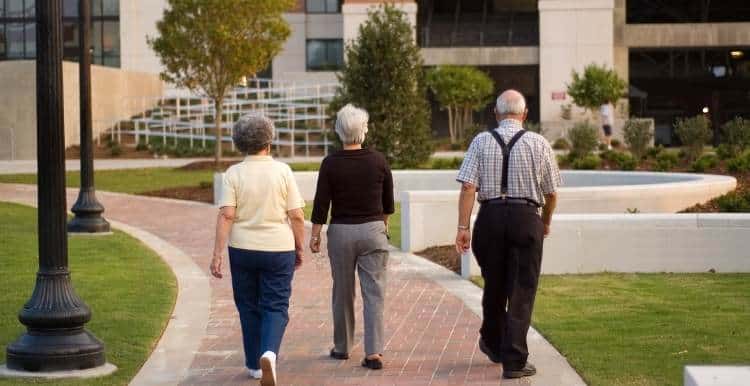
3. Easy To Integrate Into Life
The primary attraction of walking and climbing stairs is how easy they are to fit into any schedule and how they are suitable for most older adults. You only need to find a couple of stairs to start with, while walking requires you to take about 30 minutes of brisk walking.
The idea is to engage in a pace that will increase your heart rate but not leave you short of breath. Experts suggest engaging in a pace that takes your heart rate to 220 minus your age. You should, however, be able to talk to someone comfortably.
Example
If you’re 65 years of age, you will subtract 65 from 220.
220 – 65 = 155
You’re aiming for your heart rate to be no more than 155 Beats Per Minute
You do not need any specialized equipment to perform any of these two activities. However, it would help if you had comfortable clothes for a physical workout and comfortable sports shoes with proper padding to absorb the shock and cushion your soles and joints. To help track your heart rate, you could try using a fitness tracker.
For a complete guide to fitness trackers, check out my article How Can A Fitbit Benefit The Elderly: A Practical Guide.
You can easily find stairs, whether at work or an apartment, while walking trails, parks, and even the sidewalks are ideal for walking. Besides these, you need nothing else, though having a partner will help with motivation and provide you company.
There is no specialized training, and you can start small to build a comfortable routine. Then, you can keep on increasing either the pace or the duration of the activity. You can even combine the two activities to get the best of both and challenge your body in different ways, which helps promote more muscle growth.
4. Extend Your Lifespan
As we age, the risk of early death increases. Fortunately, you are not entirely powerless in stopping this, as various studies have discovered. For example, a 2019 research published by the Harvard Health Alumni Study found that climbing stairs significantly lowers the risk of death from all causes.
The study also found a connection between climbing a higher number of stairs and a lower risk of death from all causes.
As for walking, a study found that men and women in their fifties and sixties are 35% less likely to die over the next eight years compared to their counterparts who did not walk or engage in any other form of physical activity.
The number rises to 45% when looking at those individuals who have underlying health complications.
Exercise has been shown to slow down the aging process at the cellular level, which helps keep you biologically younger and reduces risks of fatal conditions like stroke or heart attack.
In addition, scientists have found that it is never too late to start engaging in physical activity as you can still reap the benefits.
People who start walking and climbing stairs in their 80s and 90s can increase their life expectancy and health benefits. On the other hand, those who used to exercise but then stopped later in life have a higher risk of chronic illness and early death.
5. Helps In Weight Loss
Being overweight and obese pose a significant health hazard for everyone. Yet, due to the bodily changes that happen as you age, the risk and impact of being obese or overweight as an older adult are significant and severe.
Obesity generally contributes to several respiratory conditions, decreasing the lungs’ size and placing extra load on them, limiting their capacity.
As we age, the lung structure and functions change, decreasing the lung size and surface available for gas exchange; obesity strains this further, leading to hypoxia, sleeping, and breathing difficulties.
Older patients are also severely affected by overweight issues, for example, skin problems, cardiovascular health, and bone health. By engaging in walking and climbing coupled with proper nutrition, you can effectively burn more calories leading to weight loss and helping you maintain a healthy weight.
Thirty minutes of brisk walking helps you burn 200 calories, while climbing stairs, which is more intensive, will help you burn 1000 calories an hour. The advantage of stair climbing is that you burn calories both as you walk up and down.
The advantages of walking and climbing stairs go even further than that when combating obesity. In a study of the genetic links in obesity, researchers at Harvard established that walking cut down the effect of 32-obesity promoting genes by half.
Engaging in physical activity has also been shown to reduce the cravings for sweet items like sugary foods, which helps you maintain a healthy and low-calorie diet necessary for weight loss.
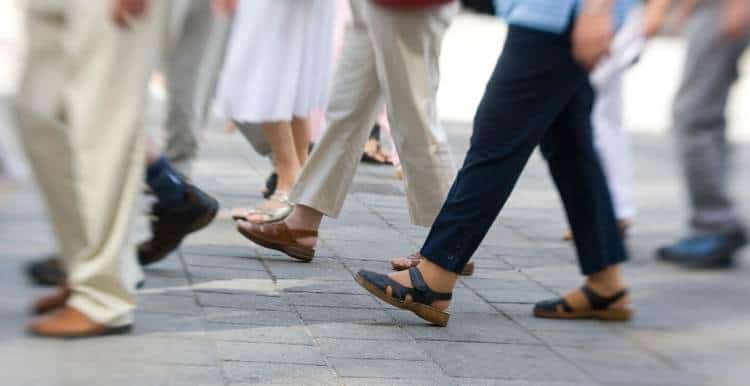
6. Improves Your Leg Strength And Balance
Even as we age, our legs remain one of the most relied on parts of our bodies to perform and execute many tasks in our daily lives.
With many adults experiencing a high risk of hip fractures and immobility, having strong legs ensures you can carry out many tasks, from lifting items to walking on your own and moving about without the need for assistance.
Walking and climbing stairs boost your overall lower body strength and engage your legs’ balancing points from the soles to the knee and hip joints.
Your leg muscles will grow stronger with repeated frequency, allowing you to carry out all your duties with ease. Legs also help you build and maintain your balance, which is essential in preventing falls and slips common among older adults, leading to injuries that could require long-term rehabilitation.
7. Improve General Fitness
Our health and fitness are generally taken for granted when we are younger. This is because the benefits of youthful health and vigor help make up for lack of general fitness most of the time unless in a competition or physically demanding tasks.
For older adults, however, general fitness is a significant barrier to enjoying their life thoroughly. For example, climbing stairs or carrying a shopping bag from the car to the house can be challenging, while a simple walk leaves them out of breath.
Reduced fitness levels increase the risk of injury even in the simplest of tasks like standing up, getting out of bed, lifting luggage, and other day-to-day tasks.
Lacking overall fitness limits how a person can enjoy their life and decreases independence. With the added risk of injury, it means you are more likely to be skipping other fun activities and relying on other people to do specific tasks for you.
Recovering from injuries that would typically heal quickly can take longer, further confining you to your bed or chair. However, by integrating walking and climbing stairs into your daily schedule, you have safe ways to increase your fitness levels, allowing you to overcome whatever limitations that come with age.
8. Engages Most Of Your Muscles
The challenge of finding one or two exercises you can use for all your fitness needs is choosing the exercises that engage multiple muscle groups. For example, when walking or climbing stairs, you engage various muscles at different stages of the movements.
In walking, for example, you engage the body’s most significant muscle, the quadriceps, which raise the leg and thigh and push them forward.
Other muscles involved include;
- hamstrings
- buttock muscles (gluteus maximus)
- calf
- core muscles
You may not realize it, but your upper body is also used to stabilize your pelvis.
Climbing stairs, on the other hand, exercises most of these muscles like the hip;
- flexors in the hips and thighs
- gluteus medius, which is on the outer thighs
- gluteus maximus found in your butt
- hamstrings muscles,
- erector spinae on your lower back spine
- calf muscles
- shin muscles (Tibialis Anterior)
The range of muscles worked are the lower legs to the core and arms for a full-body workout. It is also what makes climbing stairs and walking a good base exercise to build on before heading to the gym.
Why not try using some wrist weights for added resistance.
9. It Is An Effective Low Impact Cardio Exercise
While everyone benefits from exercise, not everyone will be able to undertake HIIT or Tabata routines and other intensive forms of cardio. In addition, as we age, our joints cannot safely sustain such intense pressure.
These types of high-intensity training will lead to poor form and increase the risk of injury. Besides, HIIT routines also bring on fatigue quicker, making it hard for people who do not exercise regularly to keep up with the required sessions, resulting in a longer recovery time.
In such cases, low-impact exercises are practical and recommended. The advantage of climbing stairs and walking is that they are still intensive enough to help you reach your goals while also involving several muscles for a good workout. In addition, low cardio workouts have shown the same benefits as regular intensive workouts, including the effect on weight loss and improving your heart rate and your fitness, as already discussed.
10. Build Your Endurance And Strength
Having excellent endurance means you can go about your daily activities without feeling tired or sore later. Climbing stairs and walking are great options for building your endurance. When climbing stairs, you are working against gravity with your body being the load your muscles have to carry and balance.
When you do it daily, you challenge your body to build new muscle fibers and manage the weight. Soon the body gets accustomed to the new demands prompting an increase in intensity or load which means walking for longer distances or climbing more stairs.
Building endurance also results in more strength. As your body builds new muscle fibers to meet the demands of the exercise, your strength increases. While it may not be at the same rate or quantity as weight training, it is enough to help you boost and sustain your energy levels and perform various duties without tiring quickly.
11. Helps Regulate Blood Pressure And Boost Your Cardiovascular Health
Walking and climbing stairs regularly allows you to improve your heart rate and strengthen your heart; after all, your heart is a muscle.
As a result, there is optimum blood circulation to all body parts and reduces narrowing or blocking of blood vessels. All these changes boost your heart’s health. As a result, you will lower your cholesterol levels, and you will start to lower your blood pressure.
Several studies have shown that walking for 30 minutes each day lowers blood pressure by at least 11 points in just 24 weeks. Climbing stairs and walking also reduce the likelihood of stroke by 20%, and if you increase your pace or do more, the risk falls by 40%. As a result, your heart becomes healthier, and you can fend off most cardiovascular diseases.
12 They Help Reduce Risk Of Disability
Physical disability is another significant risk older adults face. As bone density decreases and muscle loss progresses, older people who lead sedentary lives are more likely to develop a physical disability.
Muscles that are not being used start to shrink, and your joints and ligaments stiffen. As a result, the body’s muscles and skeletal frame cannot carry the person’s body weight, especially for the major muscle groups.
Coupled with the increased risk of falls and injuries, it explains why most older adults lose their mobility early. However, daily walking and climbing stairs reduce the risk by as much as 41%, which helps maintain your independence, and you do not have to use walking aids or require support from someone else.
13. Promote Joints Health And Fight Diseases Like Arthritis
Joints are some of the most adversely affected body parts among the elderly. This is because the joints do not have a direct blood flow, and instead, they get their nutrition and oxygen while moving through the synovial fluid, which only circulates when in motion and helps keep the cartilage in the joints healthy.
However, the joints do not get lubricated without sufficient movement, and the cartilage does not get nourishment, and the joints lose their flexibility.
For older adults dealing with arthritis or at a high risk of developing the condition, walking and climbing stairs provide a practical option for rehabilitation and overcoming the limitations the condition places on your joints.
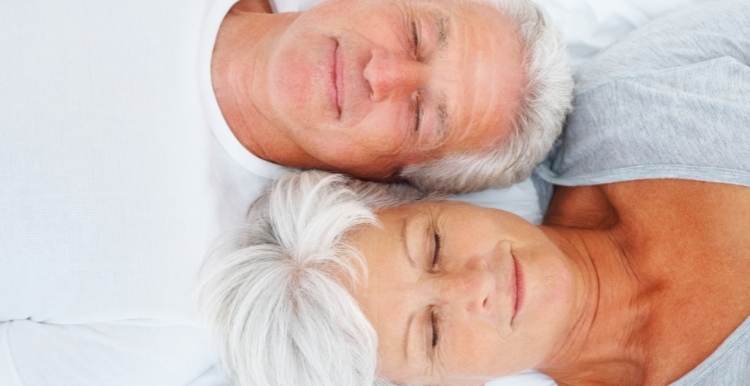
14. Promotes Better Sleep
Sleep is necessary for cell regeneration, a healthier mind, and even emotional stability. Much of your growth and body healing processes happen while you’re sleeping. Unfortunately, the sedentary lifestyle of most seniors means they do not get enough sleep or have a poor quality of sleep.
The effects are detrimental to your health and overall wellbeing. For example, poor sleep quality affects mental health leading to memory loss and problems with thinking and concentration. It also increases the risk of diabetes, leads to poor balance, and a high risk of having accidents.
Poor sleep quality also leads to;
- weight gain
- poor moods
- high blood pressure
- asthma
- acid reflux
- chronic pain
The physical exertion you have from walking or climbing stairs during the day helps you overcome insomnia and have deep refreshing sleep and all its benefits. In addition, these exercises enable you to protect all the gains you have made instead of losing them through insufficient sleep.
15. They Help To Boost Your Immune System
It is no secret that as we age, our immune systems decreases, making us susceptible to a myriad of bugs and other diseases. While adults have the best immune because of exposure to many conditions throughout their lives, as you age, this ability decreases due to several factors.
- the number of cells and antibodies used to fight diseases reduces
- T-Cells reduce their functions
- slow in reacting to disease-causing germs in the body, making the disease spread faster
Another challenge is that, as people get older, their immune system becomes less intolerant to the body’s cells, resulting in an increased risk of auto-immune diseases.
Thankfully, moderate exercise like brisk walking or stair climbing has been shown to improve your immune system. People who take such activities record fewer sick days compared to those who do not.
The two activities help you circulate the white blood cells faster to fight infections, and the temperature rise creates an unfavorable environment for the growth and spread of bacteria.
Stress is another condition that affects your immune system, and by climbing stairs, you manage your stress level giving a boost to your immune system.
16. Helps In Pain Management
Years of placing your body through strenuous work and poor nutrition or living a sedentary lifestyle catches up with you.
Your body aches almost everywhere, whether lower back pain, joint pain, or even headaches. Painkillers provide temporary relief, and some may even have side effects and generally do not address the main problems behind the pain.
Climbing stairs provides you an avenue to work out, stretch your muscles, lubricate your joints, and strengthen connecting tissues. Most of the pain is caused by weak muscles and stiff joints, and while jumping straight to the gym could cause you more harm than what you are currently experiencing, walking is a safe alternative.
Walking allows you to stretch your muscles and build strength, which alleviates the pain and aches in your body.
17. Improves General Quality Of Life
Walking and climbing stairs lead to an overall improvement in your quality of life as a senior. This effect happens on all levels. You get to reduce your weight and maintain a healthy body weight, which is an achievement you will be proud of.
At the same time, the toned body muscles and increased energy will give you confidence and raise your self-esteem. With the usual nagging aches and pains gone, you enjoy your experiences and can move around with ease and participate in events you usually would be skipping.
Conclusion
The benefits of walking and climbing stairs on your mental and emotional health also contribute to your general wellbeing.
They help keep you sharp and in good spirits preventing depression and stress. You are also in better shape to fight infections while at the same time lowering your risk of chronic diseases.
The most significant gain, though, has to be increased independence. Depending on caregivers and family members can limit how well people enjoy old age. Lacking the ability to do your shopping, moving around on your own can hurt your outlook towards life and even your social circle.
The less independent you are and how severe your disability is, the more your world is limited.
Fortunately, you can always start the journey today either to prevent the adverse effects of aging or to reverse them. You can still live your senior years with vigor, and the independence of your mid-life, so find a schedule with the help of your physician and progressively grow your challenge.
References Used In This Article
- Aging Lowers Your Immunity
- Why Stair Climbing Is The Best Exercise! – GOQii
- Benefits of Taking the Stairs
- Walking, other exercise helps seniors stay mobile, independent
- How many muscles do we use take a single step forward?
- Older Adults Advised to Walk More Briskly
- How Aging Affects Your Immune System
- The Effects of Sleep Deprivation on Your Body
- Exercise and mental health
- Climbing Stairs for Knee Pain Relief
- Low Impact Exercise and the Benefits It Has on Your Joints
- 4 Positive Reasons Why You Shouldn’t Overlook Stair Climbing as Exercise
- What muscles are involved in walking?
- 5 ways exercise helps men live longer and better
- Study highlights benefits of stair-climbing for older women
- 8 Science-Backed Health Benefits to Walking for Seniors
- Want to Keep an Aging Brain Sharp? Try the Stairs
- Adults Need More Physical Activity
- The Importance of Physical Activity Exercise among Older People
- An Overview of Current Physical Activity Recommendations in Primary Care
- NHS Exercise
- How To Determine Poor Sleep Quality



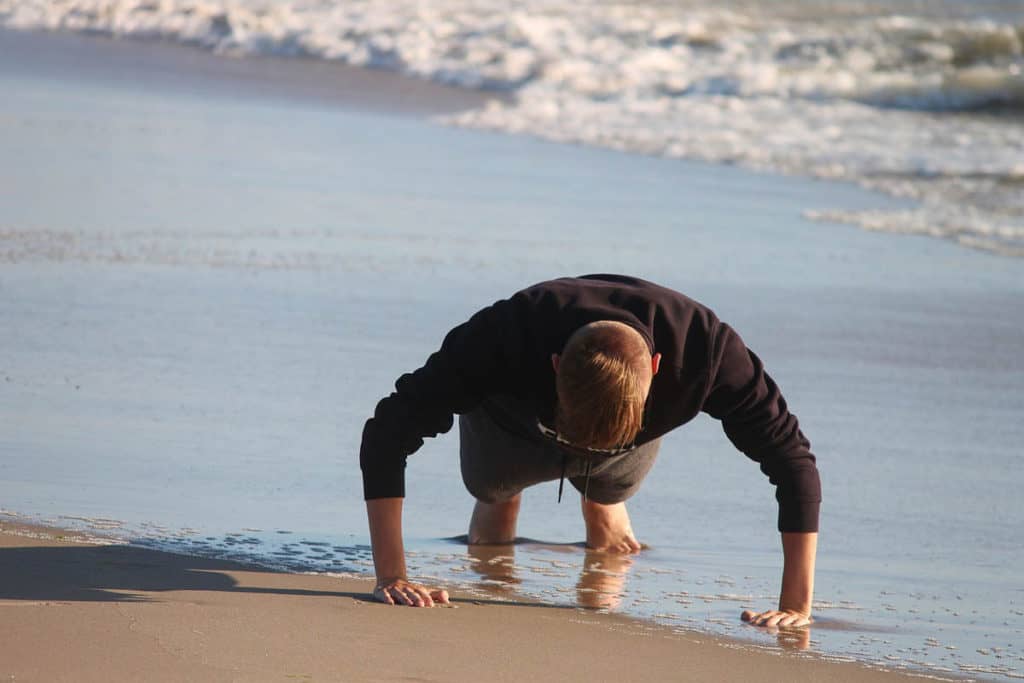
Love this! Hey go check out Yes2Next Youtube. They this week did a 10 minute video on using the stairs as a piece of exercise equipment. It is a nice workout.
Their stuff is great for the “Getting Old and Fit” crowd. Or as I like to say, Actively Aging!